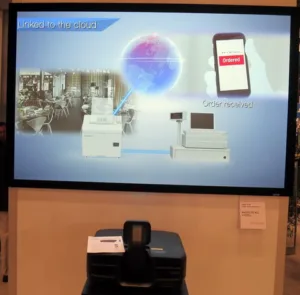Almost the only display at the NRF show that was being shown as a separate display, not part of a retail system, was the Epson Pro L1405U Laser WUXGA 3LCD projector with 4K enhancement. It was shown with a short throw lens in a back corner of the Epson booth. Since this projector was shown at both ISE 2016 in February and Technology Exposed 2016 in September and was written up in LDM after both events, I don’t need to say anything more about it. The main focus of the Epson booth at the NRF show was its small printers intended to go with POS terminals.
Epson Pro L1405U Laser WUXGA 3LCD projector at the NRF show.
SoftBank Robotics was showing off it’s humanoid robot, Pepper. This robot was about 3 feet (1M) tall and was intended to serve in such applications as meet and greet; wayfinding; order entry; and providing customers with product information. Perhaps most of all, having a robot in the store attracts many customers to the store, as can be seen in this YouTube video posted by SoftBank.
Pepper robots have a touch screen tablet attached to their chests that can show information and receive inputs. The robot has multiple sensors, including a laser range finder in the eyes, with the transmitter in one eye and the sensor in the other; cameras in its mouth and forehead; speakers in what look like ears providing a synthesized voice; microphones in the head; and sonar in the base for obstacle avoidance. The robot has Wi-Fi connectivity which is especially important for order entry.
The robot and controller are self-contained and it can follow its program and operate even when the Wi-Fi connection is lost, a frequent happening at a trade show like the NRF. The robot had surprisingly natural human gestures, including head motion, body tilt, arm waving, fingers that could open and close. Even though it did not see with its eyes, it was programmed to look at you when you were talking to it. While its arms could move and its fingers could close, the Softbank Robotics rep I spoke to said the robot could not carry anything and, when moving, did not move very fast. In an order-entry application in a restaurant, the robot would take the order, send it by Wi-Fi to the kitchen and the order would be brought to the table by a human when it was ready. In a wayfinding application, the robot could show you where to go and point, but could not lead you because of its low speed.
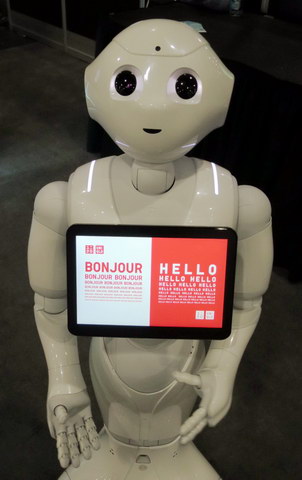 Pepper showing the Uniqlo meet and greet app in English and French on his tablet
Pepper showing the Uniqlo meet and greet app in English and French on his tablet
Software Development Kits (SDKs) for multiple platforms are available for Pepper software development. The synthesized voice is available in several languages, including English, Japanese and French. Not just the language changes, but the entire tone of Pepper’s voice changes to match cultural expectations of a ‘cute little helpful person’. OPOS (OLE for Retail POS) is a Windows software standard for retail POS applications that was initiated by Microsoft, NCR, Epson, and Fujitsu-ICL and is managed by the Association for Retail Technology Standards (ARTS). ARTS, a division of the NRF, is in the process of developing an API for Pepper which should simplify programming the robot, at least for Windows systems.
Convergent, a Ballantyne Strong company, was at the NRF show demonstrating their Digital Signage as a Service (DSaaS) technology. The photo shows a 4K Convergent solution based on multiple panels from LG. The company will install a digital signage solution in a retail store or other venue and the charge the store a fixed monthly fee. Normally, the content on the digital signage displays is controlled by the store or the brand that had the signage installed, although the Convergent rep said other business arrangements are possible. One of the goals of DSaaS is to reduce or eliminate the up-front capex cost for the store, converting everything into an ongoing expense.
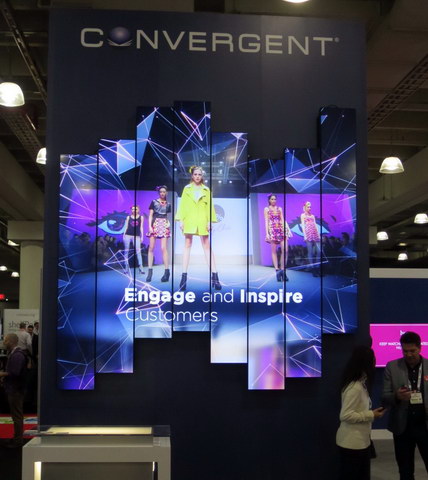 Convergent demonstrated DSaaS technology in their booth.
Convergent demonstrated DSaaS technology in their booth.
Panasonic was showing its Toughpad and Toughbook portable devices at the NRF show. This technology would not normally be used as a customer interface, either directly by customers or by a store associate. Rather, these devices are intended to be used behind the scenes in places like warehouses.
The new Toughpad FZ-A2 had been announced the week before the show and will be available in March. The FZ-A2 is similar to the original FZ-G1, which remains available. The key difference between the two is the FZ-A2 is an Android device while the FZ-G1 is a Windows device. The FZ-A2 has a 10.1″ WUXGA (1920 x 1200) IPS outdoor display (up to 800cd/m²) and a capacitive 10-finger multi-touch screen. The Panasonic rep told me a Toughpad typically has a 3 – 5 year life cycle or maybe longer. He said out of one batch of 2000 Toughpads sold to a customer over an 18 month period, there was only one failure. The unit did not fail when it was dropped by a forklift driver on the concrete floor – it failed when the folklift drove over it. In fact, he said, the unit still worked, but the screen had cracked and needed to be replaced.
He also said the company has stopped producing the company’s large 4K tablet, although one was being used to provide Toughpad information at the NRF show and is visible in the photo. He said this was popular with architects going out in the field to compare detailed drawings to actual work in the field but this was too small a market to be sustainable.
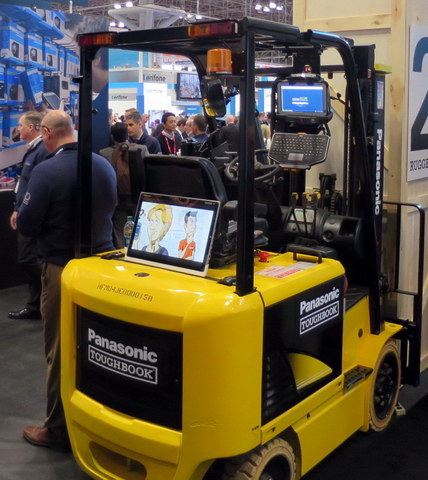 Panasonic showed its Toughpads and Toughbooks at the NRF
Panasonic showed its Toughpads and Toughbooks at the NRF
Elo Touch Solutions Inc., which claims to have invented the touch screen 40 years ago, was at the show with their full line of touchscreen digital signage displays from 10” to 70”. These displays were showing a variety of retail applications ranging from digital signage to order entry. The Elo rep told me touch screen order entry at restaurants has been shown to increase what the customer orders. He speculated that consumers may be unwilling to call out profitable things like “Put double bacon on the cheeseburger.”
In addition to stand-alone touch displays, the company showed Elo-branded POS terminals that, presumably used Elo made touch screens. The stand-alone displays were shown under slogan “In-Store eCommerce Made Easy.” In-store eCommerce means the endless aisle and omnichannel concepts. According to a survey by Elo, 66% of shoppers made a purchase in the last six months using multiple channels and 84% of consumers believe retailers should do more to integrate online and offline channels.
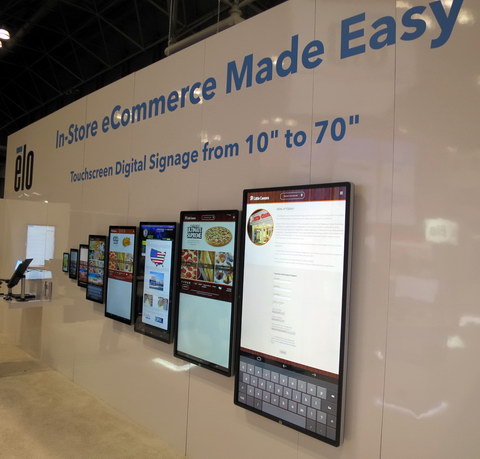 Elo touch screens from 10” to 70” were on display.
Elo touch screens from 10” to 70” were on display.
Intel announced a new ‘Responsive Retail Platform’ and a large investment in the segment to help retailers with ‘all parts of their businesses’. It will include POS and digital signage.
Analyst Comment
The NRF Big Show is too big to be covered completely by a single person. I tried to visit at least one example vendor for every retail technology that is strongly dependent on displays. In fact, this means covering almost every retail technology. Retail sales is a technology-intensive business and that business uses many displays in multiple applications. The displays are not necessarily cutting edge displays, although they are often associated with cutting edge touch screens. One vendor told me it switched touch technology in order to give consumers a more familiar touch experience, closer to what they have on their tablets and smartphones. This reduces the learning curve and allows the consumer to use the devices immediately, and ‘buy more stuff’.
While brick-and-mortar stores are threatened by on-line sales, they still dominate the retail environment. They are trying to counteract the on-line trends by introducing on-line like features into retail stores. These features typically have at least one display in them and the use of displays in retail stores is likely to increase over time, not decrease. Next year’s NRF Big Show will be January 14-16, 2018 in New York. Should be interesting. –Matthew Brennesholtz

